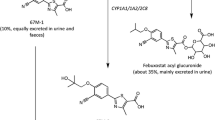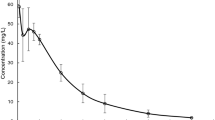Abstract
We have investigated the disposition and plasma uric acid lowering effect of oxipurinol in ten healthy individuals following oral administration of three different formulations of oxipurinol and of allopurinol in equimolar doses. The reduction of plasma uric acid was clearcut up to 48 h. As estimated from plasma AUC0-∞, Cmax, tmax, tlag, and urinary drug excretion, a conventional rapid release preparation of oxipurinol sodium was clearly superior to oxipurinol as free acid and to enteric coated microtablets of oxipurinol sodium. Plasma oxipurinol concentrations following a single dose of the conventional formulation of oxipurinol sodium were approximately 25% lower than those observed after an equimolar dose (300 mg) of allopurinol, but mean Cmax reached the value reported to be necessary for 90% inhibition of xanthine oxidase. Since prolonged administration will result in accumulation of oxipurinol because of its slow elimination, this type of oxipurinol formulation can be expected to meet the therapeutic requirements for a drug to lower plasma uric acid.
Similar content being viewed by others
References
Hitchings GH (1975) Pharmacology of allopurinol. Arthr Rheum 18:863–870
Rundles RW (1966) Metabolic effects of allopurinol and alloxanthine. Ann rheum Dis 25:615–620
Rundles RW (1985) The development of allopurinol. Arch Intern Med 145:1492–1503
Elion GB (1974) Drugs in the treatment of hyperuricemia. Adv Nephrol 3:51–57
Earll JM, Saavedra M (1983) Oxipurinol therapy in allopurinol-allergic patients. Am Fam Physician (AFP) 28:147–148
Reilly PM, Schiller HJ, Bulkley GB (1991) Pharmacologic approach to tissue injury mediated by free radicals and other reactive oxygen metabolites. Am J Surg 161:488–503
Johnson WD, Kayser KL, Brenowitz JB, Saedi SF (1991) A randomized controlled trial of allopurinol in coronary bypass surgery. Am J Heart 121:20–24
Coghlan JG, Flitter WD, Clutton SM, Panda R, Daly R, Wright G, Ilsley CD, Slater TF (1994) Allopurinol pretreatment improves postoperative recovery and reduces lipid peroxidation in patients undergoing coronary artery bypass grafting. J Thorac Cardiovasc Surg 107:248–256
Salim AS (1992) A new approach to the treatment of nonsteroidal anti-inflammatory drugs induced gastric bleeding by free radical scavengers. Surg Gynecol Obstet 175:484–490
Salim AS (1993) The relationship between helicobacter pylori and oxygen-derived free radicals in the mechanism of duodenal ulceration. Int Med 32:359–364
Chalmers RA, Krömer H, Scott JT, Watts RWE (1968) A comparative study of the xanthine oxidase inhibitors allopurinol and oxipurinol in man. Clin Sci 35:353–362
Elion GB, Yü TF, Gutman AB, Hitchings GH (1968) Renal clearance of oxipurinol, the chief metabolite of allopurinol. Am J Med 45:69–77
De Vries JX, Voss A, Kutschker C, Reiter S (1993) Simultaneous determination of allopurinol and oxipurinol in human plasma and urine by high-performance liquid chromatography. Arzneimittel Forsch 43:1072–1075
Heinzel G, Woloszczak R, Thomann P (1993) TopFit version 2.0. Pharmacokinetic and pharmacodynamic data analysis system for the PC. Fischer, Stuttgart
Breithaupt H, Tittel M (1982) Kinetics of allopurinol after single intravenous and oral doses. Noninteraction with benzbromarone and hydrochlorothiazide. Eur J Clin Pharmacol 22: 77–84
Day RO, Birkett DJ, Hicks M, Miners JO, Graham GG, Brooks PM (1994) New uses for allopurinol. Drugs 48:339–344
Walter-Sack I (1990) The significance of nutrition for the biopharmaceutical characteristics of oral controlled release products and enteric coated dosage forms. In: Gundert-Remy U, Möller H (eds) Oral controlled release products. Wissenschaftliche Verlagsgesellschaft, Stuttgart, pp 117–137
Walter-Sack I, de Vries JX, Kreiner C, Ittensohn A, Stenzhorn G, Voss A, Weber E (1993) Bioequivalence of allopurinol preparations: to be assessed by the parent drug or the active metabolite? Clin Invest 71:240–246
Day RO, Miners J, Birkett DJ, Graham GG, Whitehead A (1988) Relationship between plasma oxipurinol concentrations and xanthine oxidase activity in volunteers dosed with allopurinol. Br J Clin Pharmacol 26:429–434
Author information
Authors and Affiliations
Rights and permissions
About this article
Cite this article
Walter-Sack, I., de Vries, J.X., Kutschker, C. et al. Disposition and uric acid lowering effect of oxipurinol: comparison of different oxipurinol formulations and allopurinol in healthy individuals. Eur J Clin Pharmacol 49, 215–220 (1995). https://doi.org/10.1007/BF00192382
Accepted:
Issue Date:
DOI: https://doi.org/10.1007/BF00192382




